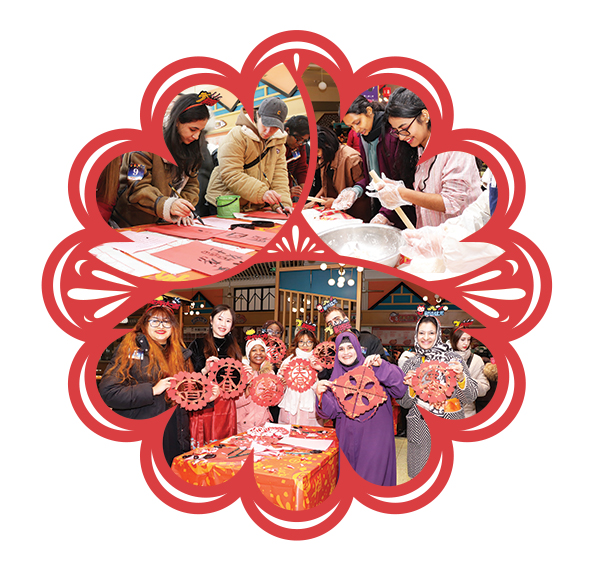

International students at Jiangsu University's Overseas Education College came together on Jan 21 for the school's 2024 Spring Festival Party to celebrate the upcoming Year of the Dragon.
The event featured various activities, including making dumplings, paper cutting, and writing Spring Festival couplets, and games like picking coin chocolates with chopsticks and playing jianzi, a Chinese shuttlecock game.
For Sonia Najam, a 29-year-old PhD student in human resource management from Pakistan, each activity carries its own special significance. For example, the act of making dumplings represents the cultural importance of preparing and sharing food with loved ones, symbolizing harmony and family bonds. Writing Chinese characters on Spring Festival couplets highlights the value of good wishes and the ancient art of calligraphy, which is deeply rooted in Chinese culture.
"Being part of traditional activities and witnessing the local community's excitement has allowed me to understand the importance of family, togetherness, and the cultural nuances of this festive season," she said.
Although both Chinese and Pakistani cultures value family, Najam said that the specific traditions and customs associated with Spring Festival distinguish the Chinese celebrations in a unique way she hadn't experienced before.
"I believe that each element contributes to the diverse tapestry of Chinese heritage and offers insights into the country's history and values," she said.
Andre M. Vaca Lucero, an Ecuadorian PhD student studying management, also appreciates the Chinese emphasis on family. She first came to China in 2009, completed her master's degree in Northwest China's Shaanxi province, and decided to return in 2022, this time as a married woman and mother of a 5-year-old boy.
"My motivation to return to China came from my son. I wanted to give him an experience that will shape his life and future."
Lucero noticed similarities between Chinese and Latin cultures in their veneration of family. "For Latin people, the warmth in our hearts originates from the warmth of our family unit," she said.
Lucero believes that the cultural value placed on family ties can contribute to fostering connections between nations. "Cultural exchanges, like this event, open opportunities for enhancing relationships among different people," she said.
Wojciech Palasz, a 22-year-old e-commerce major from Poland, was fascinated by the intricate details of Chinese traditions and the culture's attention to symbolism.
"It really impressed me when the teacher explained all the meanings of the shapes and colors during paper cutting," he said, recalling his attempt to cut out the shape of an ancient Chinese gold bullion. The teacher told him it symbolized power, wealth, nobility, and happiness.
"Chinese color culture is rich, with each color having a special meaning," he said.
The two colors that left the strongest impression on Palasz when he first arrived in China were yellow, symbolizing authority and closely linked to the ancient Chinese emperors, and red, which he described as "noticeable all around China and symbolizes fortune".
Palasz also discovered an intriguing cultural parallel between Poland and China: both nations have a tradition of making dumplings.
"I found that Polish dumplings, in fact, originate from China," he said. "While the cooking method is essentially the same, the two varieties of dumplings have different fillings."
He gave the examples of a variety of fillings, such as cheese, onion, cabbage, or even blueberries and strawberries, which are popular in Poland but rarely found in Chinese dumplings.
Fathiya Mohamed Said, a 24-year-old medical student from Tanzania, had previous experience with the Spring Festival celebrations when she first came to China in 2018. During that time, she typically took part in Spring Festival activities, such as making dumplings, with her Chinese friends.
"But this time was different. I was able to participate together with my fellow teachers and students from diverse cultural backgrounds," she said, highlighting the unity and cultural respect fostered by these activities. "What stood out to me was the enthusiasm of the international students to learn about Chinese culture and the joy and engagement we all had, as if it was a part of our own cultures."
Said took part in the lucky draw during the celebration. "Luck was truly on my side," she joked. "I won a beautiful keychain and I'm looking forward to using it as my key holder this year."
She noted that these activities have helped people develop a profound appreciation of the diversity in the world and fostered empathy and respect for different cultures.
"It serves as a platform for exchanging stories, sharing experiences, and creating enduring memories together," she said.